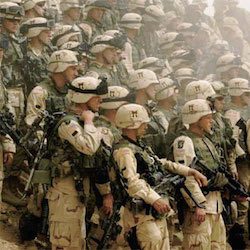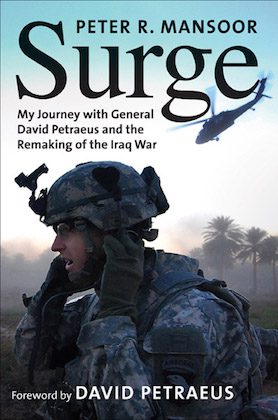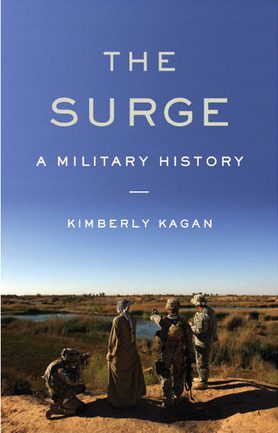
We are in the middle of a presidential campaign, and the rise of ISIS is allowing presidential candidates to describe the last decade of military engagement in the Middle East in ways that place blame and outline a vision for the future. Some assert that the Bush Administration won the war in Iraq only for the Obama Administration to lose it through withdrawal. Others argue that counterinsurgency proved a successful model that is kinder, gentler, and sustainable by America’s all-volunteer force. These assertions are both based on the narrative surrounding the “surge” of US forces in Iraq in 2007, and they are equally simplistic.
The Surge narrative essentially states that all was lost in the Iraq War due to ineffective strategy, leadership, and execution at the highest levels of the US military, but in February of 2007 General David Petraeus took command and led the nation and its coalition partners to victory. It relies on some of the facts on the grounds to make its case: the situation in Iraq was bad and at least stalemated throughout 2006; President Bush decided to “surge” troops and change commanders in early 2007; and some important successes on the ground followed those changes. But those who subscribe to the Surge narrative have to work very hard to choose and order their supporting facts. Even though General Petraeus’s star has fallen—the embarrassing biography, the guilty plea—many writers, journalists, and an entire in-crowd of military thinkers have pushed his preferred narrative. Though many books in the last decade accept the Surge narrative as fact, two seem to aim at preserving it for posterity: Peter R. Mansoor’s memoir, Surge: My Journey with General David Petraeus and the Remaking of the Iraq War (2013), and Kimberly Kagan’s The Surge: A Military History (2008).
Mansoor’s Surge and Kagan’s The Surge are strikingly different books written from completely different perspectives. Mansoor’s book is a trudge through a jungle of smallish font and footnotes. Kagan’s is a tour of the high points of the military operations that supposedly saved Iraq from civil war and America from defeat. Mansoor’s is written from the strategic level, while Kagan’s is from the operational level. The foreword to Mansoor’s book is written by General David Petraeus himself. Kagan’s husband helped pitch the Surge to President Bush. Mansoor clearly intends to preserve the case made by the Surge narrative. Kagan’s simply accepts it as fact.
 For the Surge narrative to work, readers must be convinced of a few conditions, which are intended not only to shape the story but also to minimize blame and maximize credit for Petraeus and his acolytes. First, everything that happened before David Petraeus and the Surge was a strategic failure carried out by incompetent generals and their staffs. Second, only David Petraeus was capable of turning the situation around, and even with his help it was going to be nearly impossible. Third, the Surge was a stunning strategic military success. The problem with these three conditions is that they all leave gaping logical holes that have not been sufficiently addressed.
For the Surge narrative to work, readers must be convinced of a few conditions, which are intended not only to shape the story but also to minimize blame and maximize credit for Petraeus and his acolytes. First, everything that happened before David Petraeus and the Surge was a strategic failure carried out by incompetent generals and their staffs. Second, only David Petraeus was capable of turning the situation around, and even with his help it was going to be nearly impossible. Third, the Surge was a stunning strategic military success. The problem with these three conditions is that they all leave gaping logical holes that have not been sufficiently addressed.
In Surge, Mansoor goes out of his way to hammer Petraeus’s predecessors for their prosecution of the war from 2003 through his arrival in February 2007. The generals previously in charge of Iraq were not perceptive, they had a failed strategy, and they came perilously close to losing the war before Petraeus intervened, according to Mansoor. This is a common assumption of the Surge narrative, but it poses two significant problems. First, General Petraeus was one of the generals in charge of the war prior to his arrival as commander in 2007. He led the Multi-National Security Transition Command-Iraq (MNSTC-I) organization in 2004 and 2005, which was responsible for training and equipping the new Iraqi military and police. While Petraeus was commander of MNSTC-I, the President’s stated strategy was to train the Iraqi military and police to such a level that they could replace coalition forces in providing security for the Iraqi people. But MNSTC-I under Petraeus’s leadership was never able to fulfill this mission, and the failure of the handover strategy became an argument for the Surge.
Believers in the Surge narrative give Petraeus a pass on his failure to train the Iraqi Security Forces. They also let him off the hook for training forces that had to be defeated through the Surge and beyond. The argument for the Surge described a low-level civil war between the Sunni insurgents and the Shia militias that started in earnest in February of 2006. By the time of the bombing of the Al-Askari shrine in Samarra, the catalyst for the civil war, the Shia militias were fully integrated into the police forces trained under Petraeus’s command, thus providing legitimacy for the executions they regularly conducted in Sunni neighborhoods. One does not need to blame Petraeus personally for failing to achieve the President’s stated strategy or even for training one half of the forces in the Iraqi civil war, but building a narrative that excludes and excuses him from everything that came before his time as commander is cherry-picking, at best.
Mansoor does gymnastics with his logic to account for successes in Iraq prior to 2007, since they run counter to his narrative. One such success that started before the Surge was the so-called Sunni Awakening. Sunni sheikhs, especially in Iraq’s Al-Anbar province, began to work with the coalition forces to defeat Al-Qaeda. This program began in 2006 under General George Casey, Petraeus’s predecessor. Mansoor states that this important effort was wholeheartedly embraced and enhanced by Petraeus in ways that others were either unable to do, or uninterested in doing, and that Petraeus created the model for the program when he was a Division Commander, so any success that his predecessors had was really his.
In a strange corollary to the Bush Doctrine, you are either on Team Petraeus, or you are the enemy. According to Mansoor, when Senator Harry Reid decried the Surge he was doing it for political reasons, but when Senator John McCain toured Iraq and doubled down on the Surge as a part of his presidential campaign, he was an informed leader. When Admiral “Fox” Fallon, Petraeus’s direct boss during his time as commander of the Surge forces, reviewed conditions in Iraq and the resources Petraeus required, Mansoor says he was second guessing and undermining the commander in the field. But Mansoor does not condemn the efforts of Jack Keane, a retired four-star general, who worked through a civilian think tank and backchannels to second-guess and undermine George Casey and other commanders in the field. Keane was a mentor to Petraeus.
Mansoor also goes out of his way to proclaim the Surge an unmitigated success. One might even wonder if that is the purpose of the book.
By most measures, the Surge did not achieve its goal of creating space for the Iraqi government to achieve a political solution. Mansoor cites George Casey’s oft-repeated criticism that the Surge would result in a “localized, temporary improvement in security,” in order to discount it by showing all of the ways the Surge was successful. But what Casey predicted was precisely what wound up happening. The Surge was a success, and an important one, but not as a strategic military victory. Rather, it was a domestic political success, allowing President Bush and his administration to declare victory and change the subject before handing over the keys to the White House.
 Kimberly Kagan approaches the Surge from a different direction in The Surge. While Mansoor focuses on Petraeus and the civil-military relationship, Kagan focuses on the operations—General Ray Odierno’s coordination of brigades and divisions on the Iraqi battlefields. Hers is the story behind the red and blue arrows that adorn military battle maps, showing which units attacked which enemy forces, where, and when.
Kimberly Kagan approaches the Surge from a different direction in The Surge. While Mansoor focuses on Petraeus and the civil-military relationship, Kagan focuses on the operations—General Ray Odierno’s coordination of brigades and divisions on the Iraqi battlefields. Hers is the story behind the red and blue arrows that adorn military battle maps, showing which units attacked which enemy forces, where, and when.
Kagan’s book suffers from shortcomings in style, execution, and sourcing. Reading the book is a struggle even for a reader who is deeply interested in the subject. The book offers little value to the overall discussion surrounding the Surge. Stylistically, it reads like the first draft of a doctoral dissertation. The information is there, the facts are in the right order, and the discourse is at an appropriately high level. But none of the work is thoughtfully organized.
JAM and Special Groups conducted multiple, simultaneous and successive operations to control Baghdad throughout 2006, involving combat (kinetic operations, the neologism that US forces would use) and a wide array of economic, social, and religious (non-kinetic) instruments. Their first priority was controlling east Baghdad through kinetic and non-kinetic means. They consolidated their control over east Baghdad over the second half of 2006. At the same time, they place their main effort on expansion in west Baghdad. The enemy conducted shaping operation north and south of the city in order to influence the main efforts. Their operations were very effective. Shia extremist expansion placed pressure on Sunni-populated areas in the center of Baghdad: Mansour and Karkh, Rusafa, and Adhamiyah.
There are problems with punctuation and capitalization, as well as inconsistent use of acronyms and proper names.
Finally, the sourcing. Kagan’s book includes 809 individual endnotes, which signals that she has based her case on facts. But the majority of these citations are for official press releases from entities within the Department of Defense—individual units, the Multi-National Forces in Iraq, and others. While these sources are not necessarily false, Kagan’s reliance on official military sources suggests that her purpose might be preserving the company line for the United States military instead of preparing an original, analytical, and independent work of military history.
Like Mansoor, Kagan concludes that the Surge was a wildly successful masterstroke of military strategy. In her conclusion she notes, “the general stabilization of central and western Iraq has allowed both US and Iraqi leaders to focus on problem areas in the south and north that had been under-resourced for a long time.” This may have been the case in 2008 and 2009 when her book was being completed and published, but the stabilization did not last and the breathing room that the Surge was meant to purchase never resulted in substantial political gains for Iraqi leaders.
It is unfortunate that these books insist on repeating the Surge narrative, because properly understanding what went right and what went wrong during each iteration of the Iraq War, including the period of the Surge, is crucial for understanding if and how force should be used in the future.




